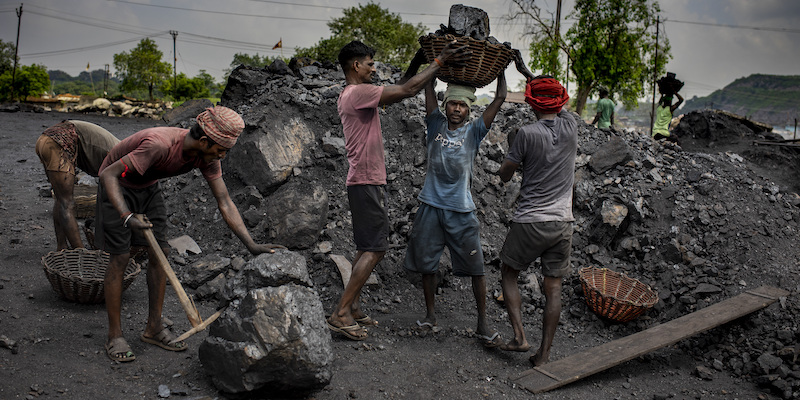On the 1st of November of COP26 in GlasgowIndian Prime Minister Narendra Modi announced that his country will strive to achieve carbon neutrality, that is, it will stop emitting more greenhouse gases into the atmosphere than it can absorb, by 2070. This promise was mocked and criticized by some, who considered it inappropriate for the climate emergency, but also called it brave and important by many newspapers. The reason for this difference in the reactions is due to the fact that on the one hand India is the third emitter of greenhouse gases in the world, and on the other hand it is the 145th country in the world in terms of GDP per capita, and has a population growth rate such that its population Today 1.38 billion people use half of the electricity produced from coal, the most polluting fossil fuel.
The situation in India is emblematic of one of the biggest problems related to the climate crisis: the difficulty of reconciling interventions to reduce emissions with the needs of countries whose economies are still in the developing world and widespread poverty among the population.
If only climate is considered, India’s goal appears to be over. China, which is responsible for 27 percent of emissions currently produced, has promised to achieve carbon neutrality by 2060. And the United States, the second-largest emitter (producing 12 percent of the total) by 2060. 2050. The same has been done before The European Union, which in aggregate also produces more emissions than India, although with a small portion of the population: both account for about 7 percent of the total.
However, judging Modi’s promise simply by looking at this graph is understated and unfair, as many environmental activists have pointed out. First of all from a historical point of view. In fact, if we take into account the emissions produced by the countries of the world over a longer period of time than in recent years, for example since 1960, then India is on the sixth place in the ranking.
However, it is not the only aspect to consider when assessing India’s role in relation to climate change. To give a fair judgment on emissions, we need to consider the number in relation to the population, i.e. per capita.
The countries with the largest per capita contribution are mostly fossil fuel-producing countries with small populations (eg Qatar, Kuwait, and the United Arab Emirates), and they are absolutely responsible for less than 1 percent of global emissions. A more likely judgment can be made by looking at the per capita emissions of the countries that contribute the most in terms of total emissions: in the ranking obtained in this way, India is at rock bottom.
Carbon Brief, a publication on climate and energy, has also attempted to make estimates about the climate responsibilities of different countries taking into account both historical emissions and populations: it is a rather complicated analysis, but suffice to know that by doing so both India and China, but also Brazil and Indonesia, do not appear in the top twenty countries with greater responsibilities.
This data must then be combined with another observation: countries with more advanced economies – the United States, Western European countries, and Japan – for years transferred part of their industrial production abroad, for example to China. And in India, where labor costs are lower and environmental protection rules are less restrictive. So, if we want to take the responsibility speech as general as possible, a portion of Indian emissions – and many Chinese emissions – can still be traced back to the US and the EU. This is similar to what can be said about plastic waste in the oceans: it comes largely from Asian rivers, but from Western countries It has been exported for decades Their plastic waste is in China and other countries in this part of the world.
Finally, it must be borne in mind that emissions are linked to economic growth and that India has so far not lifted a significant portion of its population out of poverty. According to the data of the World Bank, India’s per capita GDP was $1,900 in 2020; That Italy is worth more than 31 thousand dollars. The same can be said for many other Asian and African countries. Under the current conditions of these countries, it is inconceivable that the transition to an economy entirely dependent on renewable energy sources can occur at the same time with the already more advanced and less polluting economies such as the European economies.
However, despite the various historical and contemporary responsibilities in producing greenhouse gas emissions, the entire world today must try to reduce its emissions to avoid the worst consequences of climate change. The first major international climate agreement, the 1997 Kyoto Protocol, called for emissions cuts only from countries with more advanced economies, but since COP17, which was held in Durban, South Africa, in 2011, it was decided that for the global future cooperation was essential: an agreement Paris is of interest to all countries of the world – except for the few that have not yet ratified it.
Therefore, India’s commitment to reduce emissions was included in the agreement. It arrived later than many other countries – before Monday there was no date by which India would attempt to reach carbon neutrality – but despite appearances, it is not necessarily insufficient to achieve the goal. An increase in average temperatures of less than 1.5°C compared to pre-industrial levels.
According to the United Nations’ Intergovernmental Panel on Climate Change (IPCC) In fact, global carbon dioxide (CO .) emissions neutrality2) by mid-century, but for other greenhouse gas emissions, some of which are more complex to reduce, we could even get to 2070, the time horizon indicated by India, to achieve neutrality – having first eliminated net CO2 emissions2. Instead, to keep the increase in average temperatures below 2°C compared to pre-industrial levels (the convention’s least ambitious goal), 2070 is the year by which global CO2 neutrality can be reached.2.
The effects of the Indian promise on climate have yet to be specifically estimated, also because Modi has not provided a detailed plan on short-term goals. He only promised that by 2030 India will use non-fossil energy sources to cover half of its energy needs (Today 39 percent use them, including nuclear, according to government estimates; 20 percent according to the International Energy Agency) and that year it will cut carbon dioxide emissions by 1 billion tons without curtailing its economic activities.
Modi said nothing about what would happen in the forty years between 2030 and 2070, but he did give a rough indication of how India plans to decarbonize its economy: with the help of countries with more advanced economies. “India expects the developed countries of the world to provide $1 trillion in climate funds,” Modi said, calling for support from both his country and others in similar circumstances without specifying any part of this amount.
In 2009, at COP15 in Copenhagen, it was decided that countries in difficulty would receive $100 billion annually by 2020, but last year only 80 billion was reached. Today, developing countries want to raise funds from 2025 onwards, and Modi’s request is the highest request made. “Justice wants to put pressure on countries that have not fulfilled their promises,” the Indian prime minister said.
The main purpose of the funds agreed so far has been to fund adaptation initiatives, which would allow less affluent countries to deal with the most serious consequences of climate change, to which, among other things, they are more vulnerable than European countries and the United States. . India in particular will have a great interest in tackling global warming, as it is particularly vulnerable to weather events such as extreme heat waves and floods, which are getting more extreme due to rising global temperatures. Moreover, for Modi, the financial aid should also be used for projects to decarbonize the economy.

“Reader. Travel maven. Student. Passionate tv junkie. Internet ninja. Twitter advocate. Web nerd. Bacon buff.”




